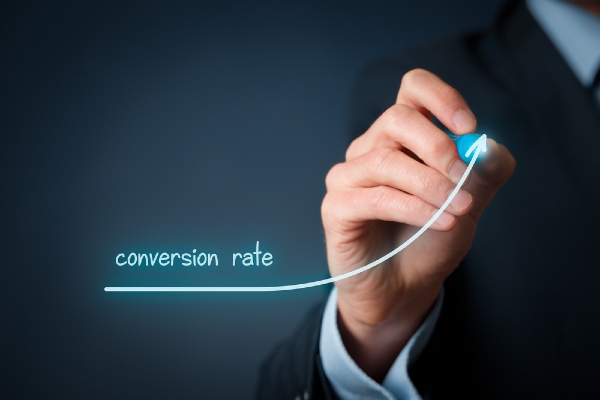Conversion Rate Optimization Basics
It’s a great feeling when you get your new website online or an updated version of your website has gone live.
Now, you’re ready to make some sales.
So, what do you do when you realize you’re getting traffic but aren’t making any sales?
You begin evaluating everything on your website and find out that you must work on optimizing your conversion rate.
Wait. What?
Don’t worry, we’re going to share everything you need to know about conversion rate optimization basics, including what it is, why you should care, and how to optimize your website!
Are you ready to dive in?
Your Guide to Conversion Rate Optimization Basics

What is Conversion Rate Optimization?
In the simplest terms, Conversion Rate Optimization (CRO) is the process of increasing the number of specific actions on your website by your visitors.
This means you are increasing the percentage of conversions on important goals that you want to measure.
Examples of Conversions Include:
- Newsletter subscriptions
- Creating an account
- Requesting a quote
- Adding a product to the cart
- Downloading a form
- Calling the phone number on the website
Why Conversion Rate Optimization is Important
Imagine you receive 1000 visits to your website today but none of the visits resulted in a single conversion.
No newsletter subscribers.
No quote requests.
No sales.
CRO is important because you can acquire more customers, but through well-researched optimizations, you’ll also reach more qualified, targeted traffic and potentially increase revenue per visitor.
Through your research and testing, you’ll learn more about your target audience to be able to provide appropriate messaging and an overall better user experience.
Conversion rate optimization is also important in advertising. You begin to understand what does and does not work with your ads in the same way you drive traffic from search or get users to convert on goals while visiting your website.
How Do You Calculate Conversion Rate?
While most analytics tools will offer CRO metrics, it may be useful to know how to calculate the conversion rate for yourself.
To begin, you need to know what your goal is (refer back to the examples of conversions).
You can utilize one of these 3 conversion rate formulas, depending on your defined conversion goal.
- Conversion Rate = Total number of conversions / Total number of sessions * 100
- Conversion Rate = Total number of conversions / Total number of unique visitors * 100
- Conversion Rate = Total number of conversions / Total number of leads * 100
What is a Good Conversion Rate?
Well, that’s subjective and there’s no concrete answer here, unfortunately.
While we may tell you that you should look for industry averages, even that can be misleading.
Crazy Egg tells us that to know the best conversion rate for your business “…you need a baseline. What is your current conversion rate? And what conversion rate do you want to achieve in the next 30 days? The next six months? The next year?”
So, pull your reports, set a baseline, and then get busy optimizing your website for conversions!
How Do I Optimize My Website for Conversions?
These are the things you can do on your website to begin your CRO efforts:
Ensure You Are Tracking Data
An important first step in optimizing your website is to ensure that you are tracking data on your website correctly.
Google Analytics and Google Search Console are free tools every website owner should use to track website data.
These tools can help visualize where visitors are coming from, what they’re doing on your site, and even how many conversions you’re receiving on your defined goals.
Without tracking your data, it will be impossible to know what you need to improve upon, much less whether your optimization efforts are paying off.
Check Out Your User Experience
When attempting to review your website for how to improve user experience and improvements, it can be difficult to remain objective. After all, the website you have online is almost exactly what you envisioned, so how could your website visitor not love it?
It’s an unfortunate fact that even with the best intentions, a website’s layout or other problems (buttons that don’t work) can influence how users interact with your site.
In their article 16 Reasons Why People Leave Your Website, Hubspot helps you to understand why you shouldn’t skip out on reviewing user experience.
Try a program like Hotjar or Microsoft Clarity that tracks user behavior on your website. With these programs, you’ll have access to valuable insights into how users interact with your website, problem areas, and areas that are doing well through heat maps or recorded user sessions.
These insights can help you make important decisions about the changes that need to be made on your website to improve conversion rates.
Start Testing
Start with a high-priority goal and see if there is a weak spot where you’re trying to drive conversions, whether it be a landing page or submission form.
Surely you have a few ideas for improvements, but implementing a bunch of major changes without a strategy might feel like a shot in the dark. And if you change what’s currently working you could experience a negative impact on conversion rate optimization.
Instead of making a bunch of huge changes to compare to the last data set in a certain time frame, try to run A/B tests of landing pages or submission forms for a specified period, based on data from Hotjar or Microsoft Clarity.
Use a program like Google’s Optimize to conduct your experiments, including order of information, language, visualizations (like button colors) and more.
Measure how your visitors respond to the changes by setting goals and compare the results of the test to determine the winner and implement that change.
Repeat these steps for each of your defined goals or problem spots on your website that appear to drive traffic away from your site instead of converting for your defined goals.
Offer Value
Take into consideration the kinds of things you expect when it comes to signing up for a newsletter or making a purchase from a website.
Do you sign up for most mailing lists simply because you stumbled on a website?
Probably not.
Most likely you found yourself compelled because you could receive a free report or a discount towards your first purchase. You were offered something in return.
When you make a purchase, you’ve found value in the item or service offered.
Use the same concepts for your website by presenting and offering value in exchange for a user’s email or their business.
When possible, present the value prominently and clearly.
Keep It Simple
Don’t use flowery or hard-to-read language.
The Clear Language Group suggests “[f]or the general public, text should be written at the 8th grade level or lower.”
If the average adult is reading at an 8th-grade level, it’s recommended to stick to simple language in your website copy.
Create a Sense of Urgency
Have you ever experienced FOMO (the fear of missing out)?
You know that seeing “low stock” on an item you need urgently prompts you to purchase rather quickly.
Offering a limited-time bonus or discount can create a sense of urgency for your website visitors to act on something when they might otherwise take time to think.
Address Concerns and Objections
What excuses are your potential customers using for not purchasing your product or service?
Is price an issue?
Do they have questions about how your product or service works?
Do they need a guarantee?
Anticipate these concerns, address them in your copy, and remove them with facts, value proposition, and any guarantees.
Remove the risk from your potential customer’s minds.
Delve Into Website Behavior Analytics
But wait. What if you don’t know your user concerns and objections?
Programs like Hot Jar can be extremely helpful in implementing:
- user surveys to learn about their concerns, objections and/or needs.
- heatmaps help you learn about user behaviors like where they click, scroll and interact.
- session recordings that show where users go on a page and where they abandon it.
The analytics they provide about your user behavior are clear and visual and can be great compliments to web analytics like Google Analytics!
Using these resources not only helps you to better understand your user objections and website experiences, but gives you a much better idea of what you need to fix to keep them on your page.
Don’t Have Time for CRO?
We understand that business owners wear many hats. It’s easy to lose a bit of the excitement of running a business that you’re passionate about when you have to tackle challenging tasks on the website.
It’s like playing analyst and psychologist instead of running your company.
If you’re not ready to dive into the complexities of optimizing your website, maybe it’s a good time to seek expert help in optimizing your website and SEO for your business goals.
Contact GYBO Marketing to help with your marketing goals so that you can focus on running your business.
Contact GYBO Marketing
[contact-form-7 id=”64″ title=”Contact form 1″]
Start Today….Grow Tomorrow!
GYBO

Passionate digital marketing expert with over 10 years of experience. Broad, hands-on marketing skillset, from web developer, SEO, PPC, Data Analytics & Tracking.
